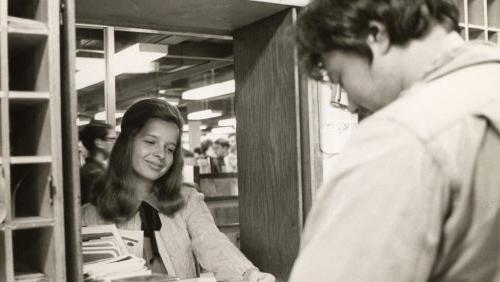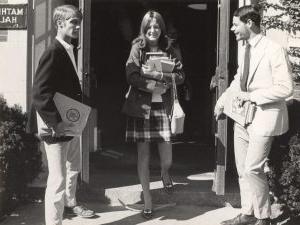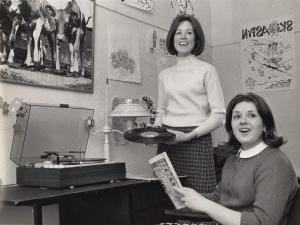Female Pioneers Play Key Role in Institution’s Evolution
Originally published in The Reporter, winter 2019.
50 for the Next 50
By Maura King Scully
For Trinity, and for many other colleges and universities, going coed was a matter of survival. When Theodore Davidge Lockwood ’48 became president on July 1, 1968, he had three major challenges: reviewing and reworking the curriculum, improving the college’s financial situation, and determining whether Trinity could continue to thrive as a men’s college. Dean of the Faculty Robert Fuller immediately took the lead in assessing the option of admitting women, writing a recommendation that persuasively argued for including women in the student body. Facing a dip in applications and the wave of schools going coed, the future was clear: the college would need to move quickly to admit top women candidates ahead of its competitors.
Kirk Marckwald ’69 was among a handful of students selected to serve on the Committee on Coeducation that Lockwood convened in the fall of 1968. “The impetus was for a small college to maintain its standing and attract both good professors and great students,” recalls Marckwald, now founder and principal of California Environmental Associates. “The big question was whether the trustees would go for it. There were a couple of pretty juicy meetings. At one, outside of Boston, a few trustees needed to be convinced that taking this step would not be the end of a meaningful football program. While we all wanted to have a good football program, it seemed a preposterous view. How would it affect the sports program? Obviously, it didn’t affect it other than ironically over the years the female athletic program accelerated and brought credit to the college.”
Writing in The Trinity Tripod’s “INSIDE” section in December 1968, David Sarasohn ’71, then features editor of The Tripod (and now a former editorial columnist for The Oregonian), had this to say: “Compelling as the purely academic reasons … the social necessity may be even more important.” He continued, “… the state of extracurricular activities at the college is lamentable” and that on “Friday and Saturday nights about half the campus flings itself at illegal speeds” toward campuses with women “while the other half sulks in the dormitory and feels sorry for itself.”
Women had actually made their way to campus as graduate students as early as the 1920s. More than four decades later, in the spring of 1969, the first female undergraduates came to Trinity through an exchange program with Vassar College. That “it is so unremarkable in my mind, it shows that it was no big deal,” recalls Marckwald. “They were smart, talented people who had great ideas and contributed well to discussions.”
Joyce Krinitsky ’73 was among the 106 female first-years in the Class of 1973, along with 49 female transfer students, statistics noted by former college archivist Peter Knapp ’65 in his authoritative tome, Trinity College in the Twentieth Century. “It was very competitive to get into Trinity,” recalls Krinitsky, a teacher who later became a real estate agent. “They actually sent a letter to the parents in which they talked about how they took only one in every 10 women.”
Krinitsky says she remembers a harsh climate. “If you walked into the dining room hall alone for dinner, you would get audibly booed,” she recalls. “Something sparked real distress in some men on campus. They had a protest sleep-out on the quad that was featured on the front page of The Hartford Courant.”
Jan Gimar ’73 notes there was resistance among some of the upper-year students. “There were those who just wanted things the way they had been, but fortunately that was not universal,” says Gimar, who spent his career as an executive with the Boy Scouts of America.
And it wasn’t just the students. “I think there were a number of faculty who had been accustomed to operating in single-sex situations who were a little bit taken aback,” Sarasohn recalls.
In Gimar’s case, he sought a coed school; indeed, he would not have applied to Trinity had the school remained single sex. “I wanted women there,” he says, looking back with fondness on the tight-knit group of women and men in his Wheaton dorm.
Alyson Adler ’73, an attorney, recalls coed dorm life with both humor and fondness. She recollects that women living in the residence halls in 1969 found ways to work around bathrooms designed for men and enjoyed the open access among the genders. “There was no barrier that would keep a guy from wandering through at any time. It was a coed dorm in every way,” she says. “A lot of schools that went coed didn’t go that far. … Trinity embraced coeducation very fully compared with other schools that went coed at the time.”
While Adler remembers sexism on campus, she doesn’t recall it as onerous. “In class, I never felt marginalized or intimidated. I was accepted by my professors, by the guys in my classes. I felt very comfortable,” she says.
Krinitsky says she thought about transferring but decided to stay. “As the year went along, I was making friends and getting happier. Despite challenges with some of the faculty, I liked where I was academically.”
Time—and numbers—also worked on the side of coeducation. “Most of us who came in with the freshman class in 1969 were distressed and worried because so many girls left after that first year,” recalls Gimar, who now is vice president of the Class of 1973. And while the college doesn’t have statistics to verify the number of women who transferred, each year brought new female students. “Every year it got better because the girls had reinforcements. The numbers made the difference by senior year.”
Cornelia “Cornie” Thornburgh ’80, who today serves as the college’s first female chair of the Board of Trustees, looks back in awe at the first women who enrolled at Trinity. “Those early classes of women were behavioral engineers, although I doubt they would refer to themselves as such,” says Thornburgh. “When I arrived on the scene in 1976 as a first-year—then still called a freshman—concerns over lavatory configurations had turned to other more meaningful matters. There were Title IX implications, sports teams had to divide resources, all-male fraternities devised ways to incorporate females into their social lives, classroom discussion had a greater breadth, and even course offerings began to incorporate new titles like gender studies.
“It’s easy to call these events evolutionary or an obvious natural progression, but I would suggest introducing women on campus some 50 years ago into our now almost 200-year history was a grand experiment in behavioral design that has transformed the essence of the college,” says Thornburgh.
That transformation has led not only to women students accounting for half of the student body and almost half of the faculty but also to women at the very top echelons of the college. In addition to Thornburgh serving as chair of the Board of Trustees since 2014, the school’s first female president, Joanne Berger-Sweeney, took the helm that same year. And the Student Government Association (SGA) currently is led by a female student, Schnadig Family Scholar Kristina Miele ’19.
Berger-Sweeney believes that these women leaders have provided a critical new lens for the college. “It is clear that women bring new perspectives when they assume an executive leadership role in an organization that historically has been led by men,” she explains. “Research shows that women are often viewed as more aspirational, empathetic, empowering of others, and more collaborative as leaders. If you asked campus constituents, they probably would say that I push our faculty, staff, and students to be less defensive, more collaborative, and more creative—taking chances when making important decisions. I also think that they would view my leadership at Trinity as less hierarchical and more inclusive in practice, not simply inclusive in rhetoric. I also ask questions that may not have been asked before in the organization.”
For example, one of Berger-Sweeney’s first moves as president was to narrow in on how sexual misconduct was handled on campus. To explore the issues involved, she organized and headed Trinity’s Task Force on the Prevention of Sexual Misconduct. “The task force led us to revise and clarify policies and to consider other issues that affect campus climate. I collaborated with College Chaplain Allison Read and the Office of Student Life to initiate the Campaign for Community. This campaign empowered student leaders to build a stronger, more inclusive community on campus and to hold their peers accountable. The work of the campaign also helped to shape many of the student life initiatives in our strategic plan, Summit,” she explains.
At the student government level, Miele is among women trailblazers, serving as only the seventh female SGA president at Trinity. “It’s a little intimidating when working with administrators and making sure I’m taken seriously by the student body,” says Miele, reflecting on how gender impacts her role. “It’s a thought, but I try not to let it be an issue. There’s always more to be done. I think it’s always important to keep the dialogue open when it comes to sexual harassment, body shaming, and women’s empowerment. There is always room for improvement.”
How women think about themselves is uppermost in Berger-Sweeney’s mind when she muses on the impact of women leaders at Trinity and the women students who look to them as role models. “I do hope to inspire our women students to help others,” she says. “I think women can form networks and try and make things better for the women who come behind them. If I could have a small influence on women here, to lead by example and give them more confidence in their ability, I feel that I would have made a significant difference at Trinity and in higher education.”
While Trinity’s coed pioneers did not have many women role models here when they arrived in 1969, they have watched—and participated in—the college’s evolution as a welcoming environment for women. Though in some ways troubled by the atmosphere that greeted her in 1969, Krinitsky came to truly love the college. She currently is serving her third term as president of her class, has held other executive alumni positions, and has donated to the college for more than 30 consecutive years.
“I think it is very important for people to know that we did not walk blithely into open arms of admiration and affection. It was a hostile atmosphere,” Krinitsky says. “But it changed, and we changed, and [our experience] helped shape us and helped shape the college.”

